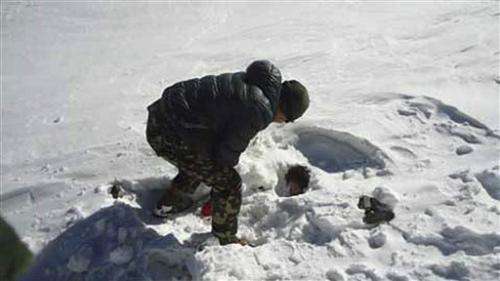In this photo provided by the Nepalese army, a Nepalese army soldier searches for avalanche victims at Thorong La pass area in Nepal, Sunday, Oct. 19, 2014. Nepalese officials closed a section of a popular Himalayan trekking route Sunday after rescuers, overwhelmed with last week's snowstorms that killed 38 hikers, had to bring to safety new climbers who set out on the same mountain trails where the blizzards struck. (AP Photo/Nepalese Army)
Nepal was wrapping up rescue operations in its northern mountains Monday, saying all the hikers believed to have been stranded on a trekking route by a series of deadly blizzards are now safe.
At least 38 people, including trekkers from Canada, India, Israel, Slovakia, Poland and Japan, died in the blizzards and avalanches that swept the Himalayas last week, battering the popular Annapurna trekking circuit.
The last flights by rescue helicopters in Mustang, Manang and Dolpa districts were planned for Monday, said Yadav Koirala of Nepal's Disaster Management Division. All the casualties were in those three districts, located northwest of the capital, Katmandu.
"We believe that all the trekkers and guides have been helped and as far as we know there are no more people stranded on the route," Koirala said, adding that some soldiers would remain camped out in the area.
So far, 34 bodies have been identified. Most of them have been flown to nearby towns or Katmandu for autopsies.
Rescuers retrieved the bodies of nine Nepalese porters Sunday from a mountain slope. The bodies were spotted a day earlier by a rescue helicopter, but it took hours for rescuers to reach them on foot.
Also Sunday, Nepalese officials closed a section of the popular Annapurna trekking circuit because new groups of hikers had been streaming into the area where most of the victims died.
The snowstorms were whipped up by the tail end of a cyclone that hit the Indian coast a few days earlier. Hikers were caught off-guard when the weather changed quickly.
Most of the victims were on or near the Annapurna trekking route, a 220-kilometer (140-mile) collection of trails through the Annapurna mountain range.
© 2014 The Associated Press. All rights reserved.























